#join indian coast guard
Text
Safeguarding the Seas: The Indian Coast Guard
Introduction
The Indian Coast Guard, often referred to as the "Sentinels of the Sea," stands as a pivotal maritime security force, entrusted with the responsibility of safeguarding India's vast coastline and exclusive economic zone. Established on February 1, 1977, the Indian Coast Guard has evolved into a dynamic and technologically advanced organization, playing a crucial role in ensuring the security and safety of India's maritime interests. This article provides a comprehensive overview of the Indian Coast Guard, its history, functions, capabilities, and the invaluable service it renders to the nation.

Historical Background
The inception of the Indian Coast Guard can be traced back to two significant maritime incidents: the 1965 Indo-Pak war and the 1971 Indo-Pak war. These conflicts underscored the need for a specialized maritime force dedicated to safeguarding India's maritime interests. In response to these challenges, the Indian Coast Guard was officially established in 1977 under the Coast Guard Act, 1978.
Roles and Functions
Maritime Security: The primary mission of the Indian Coast Guard is to ensure the security and sovereignty of India's territorial waters and exclusive economic zone. It conducts patrols, surveillance, and enforcement operations to deter and prevent illegal activities such as smuggling, piracy, and unauthorized entry.
Search and Rescue (SAR): The Indian Coast Guard is a critical player in search and rescue operations, saving lives at sea during distress situations caused by natural disasters, accidents, or other emergencies. Its swift response and state-of-the-art equipment have been instrumental in numerous rescue missions.
Environmental Protection: The Indian Coast Guard takes an active role in safeguarding the marine environment. It responds to oil spills, conducts pollution control measures, and enforces laws related to marine pollution and protection of marine resources.
Maritime Law Enforcement: The Coast Guard enforces various maritime laws and regulations, including fisheries laws, customs laws, and port security measures. It ensures compliance with these laws to maintain order and security in Indian waters.
Capabilities and Infrastructure
The Indian Coast Guard has undergone significant modernization and expansion to enhance its capabilities:
Fleet: The Coast Guard boasts a diverse fleet of ships and aircraft, including offshore patrol vessels, fast patrol vessels, helicopters, and maritime surveillance aircraft. These assets are equipped with advanced technology to fulfill various roles effectively.
Training: The Indian Coast Guard places a strong emphasis on training and skill development. It operates its training establishments, including the Coast Guard Academy in Kerala and several regional training centers.
Coastal Stations: Coastal radar stations, surveillance equipment, and communication networks have been established to improve situational awareness and response capabilities along the coastline.
Significance of the Indian Coast Guard
National Security: The Indian Coast Guard plays a pivotal role in maintaining the nation's security by preventing illicit activities and unauthorized entries into Indian waters.
Maritime Commerce: It facilitates safe and secure maritime trade by ensuring the free flow of commerce through Indian ports and waters.
Environmental Stewardship: The Coast Guard's efforts in environmental protection help preserve India's marine ecosystems and resources.
Humanitarian Assistance: The Coast Guard's search and rescue operations have saved countless lives, earning it the gratitude and trust of the Indian populace.
Conclusion
The Indian Coast Guard stands as a formidable maritime force dedicated to preserving India's maritime interests and ensuring the safety and security of its coastline. With its unwavering commitment, state-of-the-art capabilities, and dedication to the service of the nation, the Indian Coast Guard continues to be a beacon of maritime security and a vital component of India's defense and disaster response infrastructure. As it continues to evolve and expand its capabilities, it reinforces India's position as a responsible maritime nation in the global community.
#Indian Coast Guard#indian air force#police rank structure#join Indian Coast Guard#AFCAT 2 2023#Agneepath Scheme#Crack SSB 2023
0 notes
Text
Indian Coast Guard Yantrik / Navik Recruitment 2024 #trending #viral #coastguard #indiancoastguardrecuitment2024
Indian Coast Guard Yantrik/Navik Recruitment 2024 is here, and Manasa Defence Academy is your best bet for top-notch Coast Guard training. we'll dive deep into everything you need to know about the recruitment process, eligibility criteria, exam patterns, and preparation tips. With years of experience in defence coaching, Manasa Defence Academy provides unparalleled guidance to help you succeed. Whether you're aiming for Yantrik or Navik positions, our expert tips and strategies will boost your chances of success. Stay tuned to discover insider secrets and detailed insights to ace the Indian Coast Guard Recruitment 2024. Don't miss out on this comprehensive guide that could shape your future career in the Indian Coast Guard.
Call: 77997 99221
Website: www.manasadefenceacademy.com
#IndianCoastGuard#YantrikRecruitment2024#NavikRecruitment2024#DefenceAcademy#CoastGuardTraining#ManasaDefenceAcademy#RecruitmentGuide#CareerInDefence#ExamPreparation#DefenceJobs#trending#viral#manasadefenceacademy
#Indian Coast Guard Recruitment 2024#Yantrik Recruitment 2024#Navik Recruitment 2024#Manasa Defence Academy#Coast Guard training#Defence career guide#Indian Coast Guard training#Yantrik exam preparation#Navik exam tips#Indian Coast Guard eligibility#Defence recruitment tips#Coast Guard career#Indian Coast Guard jobs#Yantrik Navik guide#Coast Guard exam pattern#Recruitment process Indian Coast Guard#How to join Indian Coast Guard#Indian Coast Guard coaching#Best defence academy#Top defence jobs#Indian Coast Guard tips#Manasa coaching classes#Defence exam secrets#Indian Coast Guard syllabus#Join Indian Coast Guard 2024#Coast Guard recruitment updates#Defence coaching 2024#Indian Coast Guard success tips#Yantrik training academy#Navik training program
0 notes
Text
Indian Coast Guard Yantrik / Navik Recruitment 2023
Greetings from ADCI
Indian Coast Guard Yantrik / Navik Recruitment 2023
Coast Guard CGEPT Advt No. : 01/2024
▪️Last Date for Registration : 27/09/2023
▪️Age Between : 01/05/2002 to 30/04/2006 for ICG Navik & Yantrik
▪️Total : 350 Post
▪️10th pass student can apply
Contact us today for details
Regards
Team ADCI
9890826344
0 notes
Text
‘Pimpernel of the Hellenes’, ‘Major Paddy’, ‘Enchanted maniac’: Will the real Paddy Leigh Fermor please stand up?
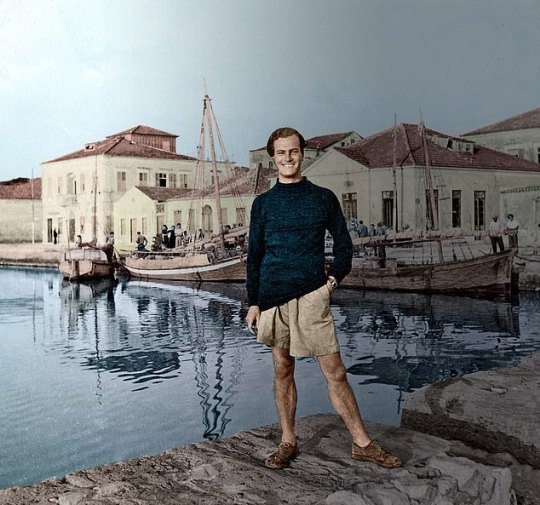
Paradox reconciles all contradictions.
- Patrick Leigh Fermor
So one evening I was baby sitting my nephews and nieces here in our family chalet in Verbier, high up in the Swiss Alps. It was my turn to baby sit as the rest of my family enjoyed the fantastic classical music concerts and events showcased at the two week long Verbier 30th Festival. The little scamps had gone to bed and my father and I watched an old British war movie on DVD, ‘Ill Met By Moonlight’ (1957). It was filmed by the legendary team of Michael Powell and Emeric Pressburger based on the 1950 book ‘Ill Met by Moonlight: The Abduction of General Kreipe’ by W. Stanley Moss.
I’ve seen the film a couple of times before, but until now never really paid attention to where the title came from. My father said it was from Shakespeare’s ‘A Midsummer’s Night’s Dream’ And so it was. In the play, Oberon, the king of the fairies and the Queen are having a fairly bitter drawn-out fight over custody of a changeling Indian child, and this is how the pissed off king greets the queen when they run into each other, “Ill met by moonlight, proud Titania”. Oberon is basically saying "Oh Lord, it's you..." and Titania's response is basically a flippant middle finger. One of the best modern reasons to read Shakespeare: to throw playful erudite shade at others.
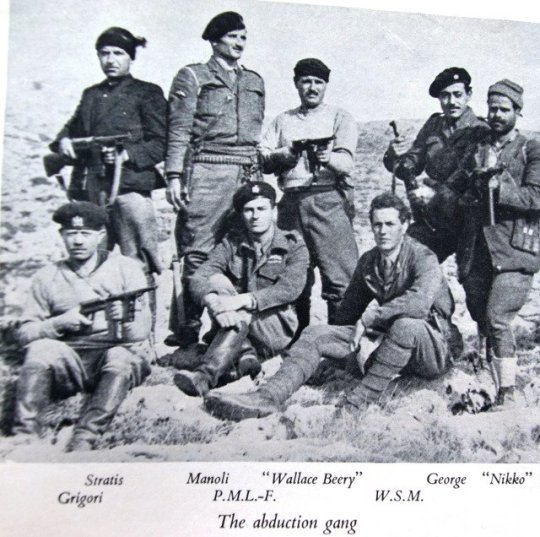
Anyway, the historical background of the film is the German invasion of Crete in May 1941. After an intense ten-day battle, Allied troops were driven back across the island, and many were evacuated from beaches along the southern coast. Some Cretans and British officers took to the mountains to organise resistance against the occupying forces. The German occupation that followed was especially brutal. Dreadful reprisals followed every act of resistance. The German commander, General Müller, insisted on taking 50 Cretan lives for every German soldier killed; he became known as ‘The Butcher of Crete’.
As a Classicist side note, there had been a close association between Britain and Crete since the early 20th century, when archaeologist Sir Arthur Evans had uncovered the sensational remains of a Minoan palace at Knossos. The headquarters of the British archaeological school in Crete was a large villa alongside the site, known as Villa Ariadne. Several archaeologists, who knew the island and its people well, went underground after the German occupation to aid the Cretan resistance. Continuing in this tradition, scholar and travel-writer Patrick Leigh Fermor, who had got to know Greece in the 1930s, joined the Special Operations Executive (SOE).
During the German occupation, Major Paddy Leigh Fermor travelled to Crete three times to help organise local resistance against the hated German occupation. On the third occasion, in February 1944, he was parachuted in with a specific mission to kidnap German commander General Müller, to boost morale on Crete along with his erstwhile SOE comrade Capt. W. Stanley Moss MC (aka Billy Moss) of the Coldstream Guards. However, just after they parachute in, General Müller was replaced by General Heinrich Kreipe, who transferred from the Russian Front. Thinking that capturing one general was as good as another, Fermor merrily go ahead with the daring kidnap operation.
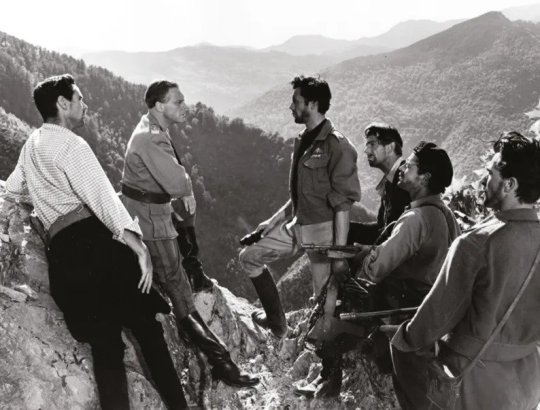
It’s at this point that the narrative of Michael Powell and Emeric Pressburger’s ‘Ill Met by Moonlight’ (1957) picks up. Dirk Bogarde plays Paddy Leigh Fermor, David Oxley plays Moss, and Marius Goring plays the taciturn German paratroop general. Blink and you’ll miss the late great Christopher Lee making a cameo appearance as a German officer in the dentist’s room scene.
The film naturally takes some liberty with the facts but it’s a cracking yarn of high adventure and drama. Xan Fielding, a close friend of Leigh Fermor from the SOE in Cairo, was taken on as technical adviser. The fact the film was shot in in the Alpes-Maritimes in France and Italy, and on the Côte d'Azur in France, far away from the craggy valleys and mountains of Crete itself. The director Michael Powell spent some time walking in Crete to get to know the island, but decided that, with the confused and volatile state of Greek politics, it was not suitable to film there.
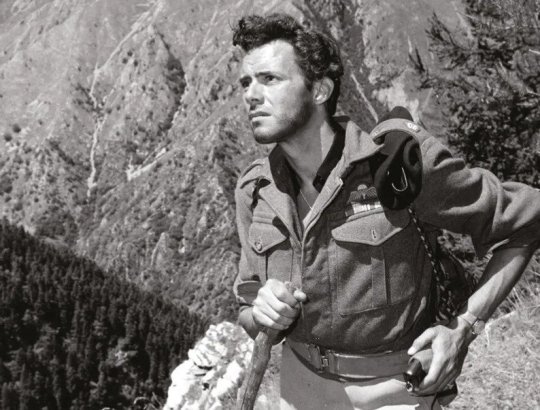
Looking back years after he had directed it Powell didn’t think much of his own film. By contrast, Paddy Leigh Fermor, who was on set throughout the film shoot, was very happy with Bogarde’s portrayal of him with Byronic glamour. Watching the movie again ‘Ill Met by Moonlight’ remains a classic and stands out from many British war films of the 1950s because of its realism. The British SOE men and the Cretan guerrillas look absolutely right for their parts. It is dramatic and full of suspense while filled with much boyish humour.
I was disappointed with one notable omission in the film that did happen in real life. According to Patrick Leigh Fermor, at dawn one day during the journey across the mountains, General Kreipe was looking at the mist rising from Mount Ida and began to recite, in Latin, the opening lines of Horace’s ninth ode:
Vides ut alta stet nive candidum
Soracte nec iam sustineant onus
silvae laborantes geluque
flumina constiterint acuto?
Behold yon Mountains hoary height,
Made higher with new Mounts of Snow;
Again behold the Winters weight
Oppress the lab’ring Woods below:
And Streams, with Icy fetters bound,
Benum’d and crampt to solid Ground
(John Dryden 1685)
Leigh Fermor picked up on the General, and recited the remaining stanzas of the Ode. ‘Ach so, Herr Major,’ said Kreipe when Leigh Fermor had finished. Both men were amazed to realise they shared a classical education and a love of ancient Latin poetry.
Leigh Fermor later wrote that it was as though the war had ceased to exist for a moment, as ‘We had both drunk from the same fountains before.’ It brought captor and captive together with a strange bond. The scene was not reproduced in the film, as Powell and Pressburger probably thought it would make the men sound too academic for a popular cinema audience.
Leigh Fermor and Kreipe met again in the early 1970s, on a Greek television show, and got on famously together. The General said Leigh Fermor had treated him chivalrously as a captive. They remained friends until Kreipe’s death.

After sharing a late night drink with my father after the film, I began to muse on the figure of Paddy Leigh Fermor, a family friend and someone I met along with his wife, Joan, as a little girl. My grandparents, and especially my grandmother, knew Paddy briefly from their days during and after the Second World War.
My father shared a few stories about him when he and my mother visited his beautiful home in Greece, where even at his advanced age he remained the most generous of hosts and the most outrageous flirt.
One of my memories was getting into his battered old Peugeot in the drive way and trying to drive it when my feet could barely touch the pedals. It wouldn’t have mattered in any case as the brakes didn’t work as he cheerfully said later as we careened around a dirt road to go around the mountains for a drive.
Many years later in April 2022, I tried to visit the home of the late Patrick and Joan Leigh Fermor - a sort of pristine shrine to their memory that one can also stay in any of the rooms as a vacation rental - in the coastal fishing village of Kadarmyli in the Peloponnese, as part of a hiking and mountaineering sojourn around Greece with ex-Army friends. We couldn’t stay there as it was already rented out to other guests, and so we stayed higher up the mountain in a villa, but we swam in front of the Fermor’s home which was on the water’s edge.
You could never put your finger on Paddy Leigh Fermor. He hid behind his gift for telling yarns, and pulling Ancient Greek verses out of the thin air, as well as boisterously singing local Greek songs with a drink in his hand.
Even after his death in 2011, the question keeps nagging as to who was Paddy Leigh Fermor?
The Dirk Bogarde film too seems to ask, who exactly is the ‘real’ Patrick Leigh Fermor - or the real anyone? Taking its title from a Shakespearian play concerned with dreams and disguises, magic and power, ‘Ill Met By Moonlight’ is all about questions of identity.
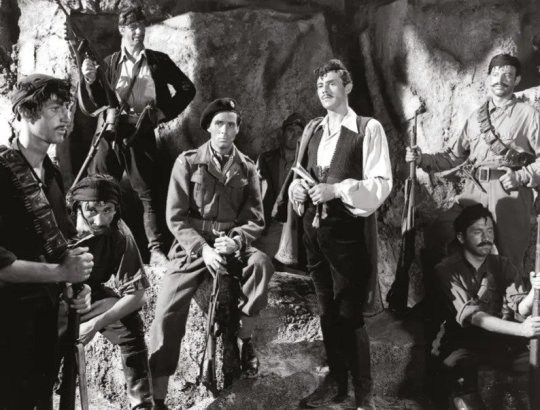
Under the film credits, we see Dirk Bogarde in uniform; then, unexpectedly, we see him in the flamboyant outfit of a Cretan hill-bandit. A title informs us that Major Leigh Fermor was also known by the Greek code-name “Philidem.” In other words, there are two of him (at least), and on one level the adventure the film is about to unfold reflects a conflict in his personality. It’s a conflict shared, unknowingly, by his Nazi opposite number, the fierce, arrogant General Kreipe (an unlikely “proud Titania,” but it’s true that he “with a monster is in love” – the monster of Nazism). Kreipe’s human side is so rigorously repressed by the demands of war and “glory” that he is genuinely unaware of it; ironically, this humanness, which constitutes the true manhood of this Teuton warrior, is revealed by a boy (equivalent to Shakespeare’s Indian Prince?) - who, in turn, is the most grown up person in the movie.
If “Philidem” appears under the credits, caped and open-shirted, a romantic dream-figure out of an operetta or a storybook, he is first seen in the film proper as a coarser, more down-to-earth version of the same thing – an ordinary Cretan peasant in a shabby suit, waiting for a bus. When he makes contact with the Resistance, his personality fragments further.
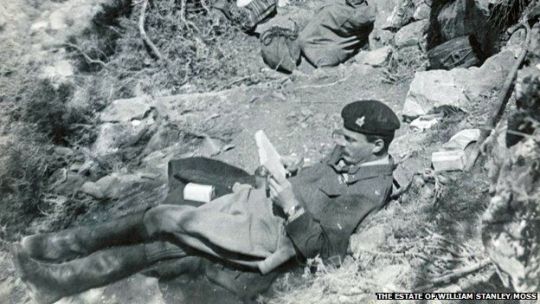
To some, he is the mystical Philidem, Pimpernel of the Hellenes and righter of wrongs. To others he is “Major Paddy,” the happy-go-lucky Englishman of popular movie myth conducting war as if it were a branch of amateur theatricals, a gentleman adventurer relying on breeding to get him through and making fun of the whole business. To Bill Moss (David Oxley), the newly arrived junior officer sent to assist him, he is the cool, fast-thinking professional soldier. And to himself? In his quietly passionate defence of Cretan life and culture, he seems someone else again: a scholar and aesthete outraged by the barbarism and folly of war, and by the moronic arrogance shown by his captive toward the Cretan people.
Whatever his persona, Leigh Fermor is a chameleon who never seems to change very radically in himself. Perhaps because he has this quality of seeming all things to all men – and being those things - he remains unfazed by the monolithic might of the German military machine. Fluent in Greek, he can also speak German like a German and is easily able to assume another disguise, that of a faceless Nazi officer. Although he and Moss make fun of themselves - “If only I had a monocle!” muses Moss when Leigh Fermor tells him he “looks like an Englishman dressed like a German, leaning against the Ritz bar” - they are able to effect the kidnapping with an ease that seems appropriately Puckish. General Kreipe is ignominiously thrust onto the floor of his own limousine, gagged, and sat upon by a couple of the peasants he so despises. Kreipe’s rage is compounded by his firm conviction that he has been snatched by “amateurs” - a belief Leigh Fermor and Moss slyly make no objection to, knowing how it will gnaw at his already shaky Master Race self-confidence.
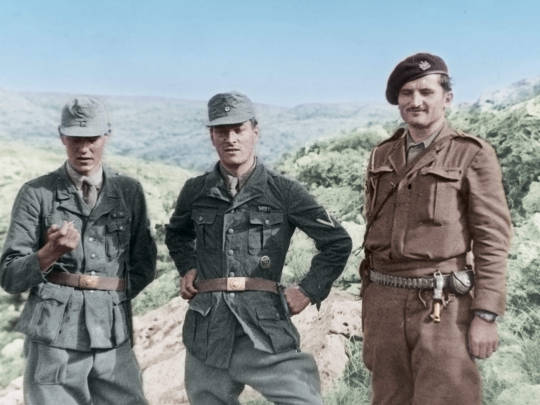
Patrick Leigh Fermor, aka Major Paddy, aka Philidem, in the film’s closing moments, is far from being self-assured intellectual or dashing amateur adventurer or legendary outlaw of the hills. He’s just a tired man who wants to go home and rest up. “How do you feel?” asks Moss. “Flat” is the reply. “You look flat!” says Moss. “I know how I’d like to look …” murmurs Leigh-Fermor wistfully. Moss knows what he’s going to say, and joins in the litany: “Like an Englishman dressed like an Englishman – and leaning against the Ritz bar!” It’s easy to imagine them ordering drinks at that renowned watering-hole with all the suavity required by this little fantasy.
Still, the film’s last images of Crete receding in the distance, until all we can see is the sea, suggests that maybe Major Paddy’s heart is really back in those hills in the “fair and fertile” land that has become as much a Powellian landscape of the mind for us as the studio-built Himalayan convent of ‘Black Narcissus’ or the monochrome Heaven of ‘A Matter of Life and Death’. And, as the film POV closing shots departs both Crete and this film, I began to think that being “dressed like an Englishman and leaning against the Ritz bar” would, for Patrick Leigh Fermor constitute yet another disguise. After all, he said he was of Irish aristocratic stock.
Traveller and writer Paddy Leigh Fermor is best known for two events. He’s known for leading the commando group in occupied Crete to kidnap General Kreipe. But he is also known for the boy who, at a mere 18 years old, set off with little money and a lot of nerve in 1933 to walk from the Hook of Holland to Constantinople.
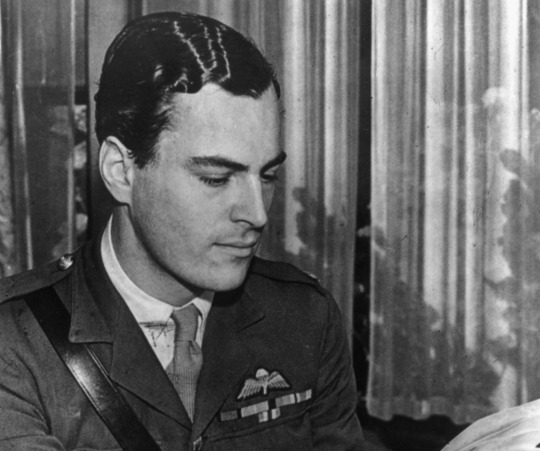
Patrick Leigh Fermor was, in the words of one of his obituaries, a cross between Indiana Jones, James Bond and Graham Greene. Self-reliance and derring-do were lessons learnt from the cradle. When Fermor’s geologist father was posted to India, he and his wife left the infant with family in Northamptonshire and did not return until his fourth birthday. In retrospect, he took great delight in being sent to a school for difficult children and getting himself expelled from the King’s School, Canterbury, when he was caught holding hands with a greengrocer’s daughter eight years his senior. His school report infamously judged him ‘a dangerous mix of sophistication and recklessness’.
Sharing a flat in Shepherd’s Market, one of Mayfair’s seedier corners, Leigh Fermor schooled himself in literature, history, Latin and Greek.
He honed his character with the company of extraordinary people and the words of great writers - he had a prodigious memory for prose as well as poetry. He befriended literary lions such as Sacheverell Sitwell, Evelyn Waugh and Nancy Mitford. His travels began aged ‘eighteen-and-three-quarters’ when he rejected Sandhurst Royal Military College in order to walk the length of Europe from Hook of Holland to Constantinople. He took with him Horace’s Odes and the Oxford Book of Verse though Leigh Fermor could recite Shakespeare soliloquies, Marlowe speeches, Keats’s Odes and as he modestly put it ‘the usual pieces of Tennyson, Browning and Coleridge’ from memory.
Leigh Fermor was then a self-made man in the most literal sense.

Setting off from England in 1933, Fermor resolved to traverse Europe living like a hermit; sleeping in bars and begging for food. But his manly charms and boyish good looks found him being passed like a favourite godson from Schloss to palace by European nobility and he developed a lifelong penchant for aristocratic company. I his own words, ‘In Hungary, I borrowed a horse, then plunged into Transylvania; from Romania on into Bulgaria’. Having reached Constantinople in January 1935, Fermor continued to explore Greece where he fought on the royalist side in Macedonia quelling a republican revolution. In Athens Leigh Fermor met Balasha Cantacuzene, a Romanian countess with whom he fell in love. They were living together in a Moldovan castle when World War Two was declared.
Fluent in Greek, Leigh Fermor was posted as a liaison officer in Albania. Recruited as a Special Operations Executive (SOE), he was shipped from Cairo to German-occupied Crete where he lived disguised as a shepherd in the mountains for two years. On his third expedition to Crete in 1944, Leigh Fermor was parachuted alone onto the island and made connections in the Cretan resistance movement. While waiting for his compatriot Captain Bill Stanley Moss to land by water from Cairo, Leigh Fermor hatched a plot to kidnap German Commander General Heinrich Krieple. He liaised comfortably with Cretan partisans and bandits to pull off one of the war’s greatest coups de théâtre.

Disguised as German soldiers, Leigh Fermor and Moss stopped Krieple’s car at an improvised check point en route back to Nazi HQ in Knossos. Abandoning the General’s car after a two-hour drive, Leigh Fermor left a note indicating that the kidnappers were British so that there wouldn’t be reprisals against Cretan nationals. When the abduction of the unpopular commander was discovered, a German officer in Heraklion allegedly said ‘well, gentlemen, I think this calls for champagne’. It turns out that General Kreipe was despised by his own soldiers because, amongst other things, he objected to the stopping of his own vehicle for checking in compliance with his commands concerning approved travel orders. It’s why for instance the German troops, both in the film and in real life, dare not stop the General’s car as it drove through the check points at Heraklion.
Krieple was evacuated and taken to Cairo and Leigh Fermor entered the annals of World War Two’s most devil-may-care heroes. With characteristic panache, when he was demobbed Leigh Fermor moved into an attic room at the Ritz paying half a guinea a night. But his first travel book, ‘The Traveller’s Tree’, was not about the European odyssey or the Cretan escapades and centred on Leigh Fermor’s adventures in the Carribbean. Published in 1950, ‘The Traveller’s Tree’ was an inspiration for Ian Fleming’s second James Bond novel ‘Live and Let Die’ (1954).
As a host and house guest, Paddy Leigh Fermor was much sought-after. At one of his parties in Cairo, he counted nine crowned heads. He was a confirmed two-gin-and-tonics before lunch man and smoked eighty to 100 cigarettes a day. His party pieces included singing ‘It’s a Long Way to Tipperary’ in Hindustani and reciting ‘The Walrus and the Carpenter’ backwards. In Cyprus while staying with Laurence Durrell, Leigh Fermor apparently stunned crowds in Bella Pais into silence by singing folk songs in perfect Cretan dialect. As Durrell wrote in ‘Bitter Lemons’ (1957), ‘it is as if they want to embrace Paddy wherever he goes’.
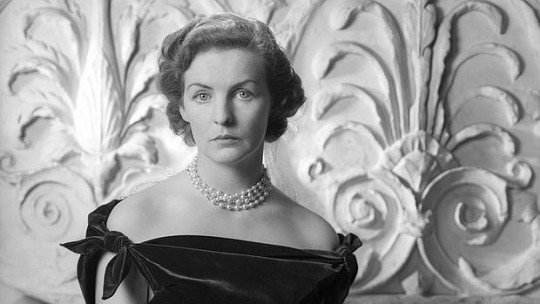
He struck up a partiuclar friendship with the famous Mitford sisters, especially Deborah Mitford, later ‘Debo’, the Duchess of Devonshire. It was at the Devonshires’ Irish estate Lismore Castle that ‘Darling Debo’ and ‘Darling Pad’ met and began to correspond. A characteristic letter from the Duchess in 1962 reads ‘The dear old President (JFK) phoned the other day. First question was ‘Who’ve you got with you, Paddy?” He’s got you on the brain’ to which Fermor replies of a broken wrist ‘Balinese dancing’s out, for a start; so, should I ever succeed to a throne, is holding an orb. The other drawbacks will surface with time’.
After the war he travelled widely but was always drawn back to Greece. He built a house on the Mani peninsula - which had been, significantly, the only part of Magna Graecia to resist Ottoman colonisation since the fall of Constantinople in 1453. Before his death in 2011 at the age of 96, he wrote some of the most acclaimed travel books of the 20th century.
His books contain some of the finest prose writing of the past century and disprove Wilde's maxim that "it is better to have a permanent income than to be fascinating".
Charm, self-taught knowledge and enthusiasm made up for the lack of a university degree or a private income. His teenage walk across Europe and subsequent romantic sojourn in Baleni, Romania, with Princess Balasha Cantacuzene are proof enough of that. But the difficulty of capturing such an unconventional and glamorous life is made harder by the certainty that Fermor was an unreliable narrator.

He was also an infuriatingly slow writer. Driven by a life-long passion for words yet hampered by anxiety about his abilities, Leigh Fermor published eight books over 41 years.
‘The Traveller's Tree’ describes his postwar journey through the Caribbean; ‘Mani‘ and ‘Roumeli’ (1958 and 1966) draw on his experiences in Greece, where he would live for much of the latter part of his life. But it is the books that came out of his trans-Europe walk that reveal both the brilliance and the flaws. ‘A Time of Gifts’ was published in 1977, 44 years after he set out on the journey. ‘Between the Woods and the Water’ appeared nine years later. Both describe a world of privilege and poverty, communism and the rising tide of Nazism, and end with the unequivocal words, "To be continued". Yet the third volume hung like an albatross around the author's neck. As the years passed, Fermor found it impossible to shape the last part of his story in the way he wanted.
Leigh Fermor was that rarest of men: a man determined to live on his own terms, if not his own means, and who mostly - and mostly magnificently - succeeded. Always popping off on a journey when he should have been writing about the last one, always ready to party, he was forever chasing beautiful, fascinating or powerful women, even when with his wife, Joan Raynor. She was the great facilitator who funded his passion for travel and writing, as well as women, from her trust fund. His love affairs were discreet but legendary.
Leigh Fermor was happiest among the rogues. Over a lifetime on the road, he sought them, and in turn they responded to his charm, nose for adventure, and his famous wit. He was a keenly-anticipated dinner guest - once outshining Richard Burton at a London society soirée, who he cut-off midway through a recital of ‘Hamlet’. As Richard Burton stormed out, the pleading society hostess said, “But Paddy’s a war hero!” to which Burton grouchily replied, “I don’t give a damn who he is!”
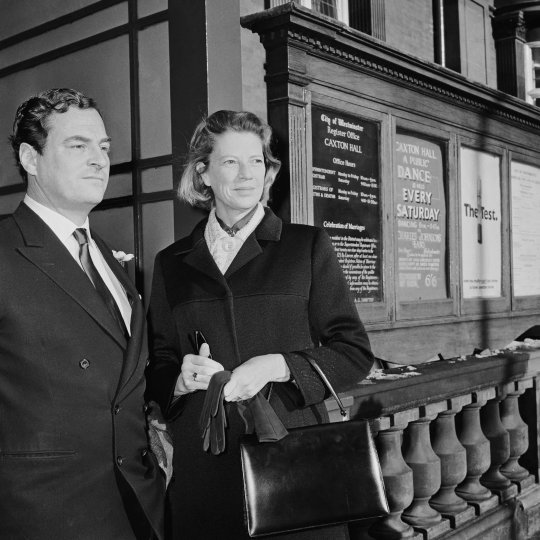
His partnership with and then marriage to Joan Raynor was an open relationship, at least on Leigh Fermor’s side. Paddy saw in Joan his kindred spirit. Like him, she spent much of her youth travelling to where she pleased; largely in France, where the photographer and literary critic Cyril Connolly became besotted by her. Joan was the daughter of Sir Bolton and Lady Eyres Monsell of Dumbleton Hall, Worcestershire. She was not only stunningly pretty but also 'a beautiful ideal, with the perfect bathing dress, the most lovely face, the most elaborate evening dress', as the Eton educated Connolly described her. Joan also stood out from the upper-class beauties of her day in that she supplemented her mean rich father's allowance by earning her living as a decent photographer.
In 1946, she met Leigh Fermor in Athens, while he was deputy director of the British Institute. Joan met him at a time when he was then in a relationship with a French woman called Denise, who was pregnant with his child, which she aborted. The pair would travel to the Caribbean together under the invitation of Greek photographer Costas, falling madly in love.

She was the only woman that - after decades of sexual scandals - matched his own erratic behaviour. Stories of how they dined fully-clothed in the Mediterranean, dragging a table into the sea, as well as their myriad cats and olive groves, paint a restless couple, who, when not out articulating the peoples of their adopted homeland, kept themselves very busy.
The attraction between Paddy and Joan was instant. So many love affairs that Paddy indulged in seemed about as brief as the flame from a burning envelope and you expected this one with Joan to be too. But somehow, miraculously, it lasts.
The two were apart a great deal, but in their case, absence did make the heart grow fonder. While Paddy was staying in a monastery in Normandy, supposed to be thinking monk-like thoughts that he would eventually put into his masterpiece A Time To Keep Silence, he was also writing sexy letters to Joan: 'At this distance you seem about as nearly perfect a human being as can be, my darling little wretch, so it's about time I was brought to my senses.' And: 'Don't run away with anyone or I'll come and cut your bloody throat.'
She tantalised him with descriptions of Cyril Connolly making passes at her; but she, like Denise, sounded a rather desperate note when she wrote: 'I got the curse so late this month I began to hope I was having a baby and that you would have to make it a legitimate little Fermor. All hopes ruined this morning.'
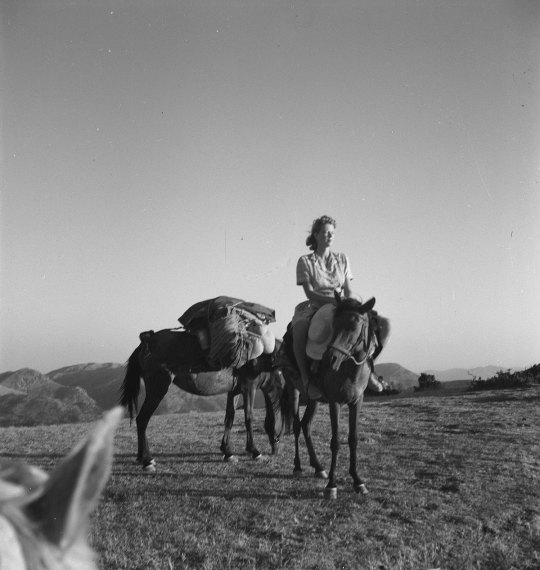
Fiercely independent - a trait that must have enamoured Paddy - they were best imagined as two pillars of a Greek temple, beside one-another but capable of holding up the roof of the world that they had built for themselves through the lens of ancient history and Hellenic culture. Indeed, it was said that they had a special ‘pact of liberty’. It is this unconquerable aura that led poet laureate John Betjeman to declare his love for her (he called her ‘Dotty’ and remarked that her eyes were as large as tennis balls). For Cyril Connolly, the photographer she shadowed, and with whom she had a scandalised affair during her first marriage, she was a “lovely boy-girl” and Laurence Durrell named her the ‘Corn Goddess’ because of her slender figure and short hair. But of all of these worthy candidates, it was the warrior-poet Patrick Leigh Fermor who finally won her heart.
To Joan, who described herself as a ‘lifelong loner’ in her diaries, her companionship with the uncomplicated Paddy was a relief. They had no children, nor did they want any - or so Paddy claimed. But those who knew Joan suspected she did want children but it never came to pass; and so she became a devoted aunt or dotted on other friends’ children. For both of them their dozens of cats gave them the next best thing to paternal satisfaction. Still, her morbid fascination with photographing cemeteries painted a much darker side.
Joan Raynor’s inheritance subsidised his peripatetic life at least until the enormous success of ‘A Time of Gifts’ in the late 1970s, which in turn created a new market for his previous volumes about Greece, ‘Mani’ and ‘Roumeli’.
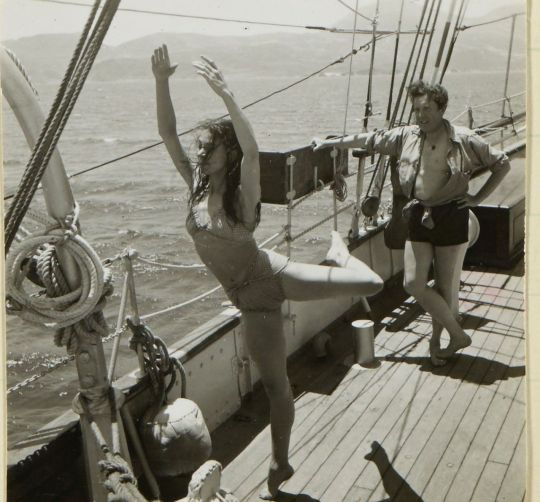
With Joan’s tacit consent, Paddy enjoyed amorous flings, discrete sexual affairs with high society women and sampled the low delights of the brothel. This activity rarely made it into his private letters, but the exceptions could be piquant. Writing in 1958 from Cameroon, where he was on the set of a John Huston movie, he told a (male) friend: “ Errol Flynn and I . . . sally forth into dark lanes of the town together on guilty excursions that remind me rather of old Greek days with you.” In a 1961 letter to the film director John Huston’s wife, Ricki, with whom Leigh Fermor had been having sex with (and would die in a car crash in 1969). “I say,” the passage begins, “what gloomy tidings about the CRABS! Could it be me?” Riffing on pubic lice and their crafty ways, he conjectures that, during a recent romp with an “old pal” in Paris, a force “must have landed” on him “and then lain up, seeing me merely as a stepping stone or a springboard to better things” - to Mrs. Huston, that is. As comic apologies for venereal infection go, the passage is surely a classic.
Like most high flying lives, it was far from blameless. Wounded women were littered in his wake. Some British visitors to Athens were less than impressed by this Englishman who posed as “more Greek than the Greeks”.
Some Greeks shared their disdain. Revisionist historians criticised his role in wartime Crete, and warned their fellow Hellenes that for all his fluency and charm, Leigh Fermor was no latter day Byron. His unoccupied car was blown up outside his Mani house, probably by members of the Greek Communist Party which he had vocally opposed. The accidental fatal shooting of a partisan in Crete led to a long blood feud which made it difficult for Leigh Fermor to re-enter the island until the 1970s, and possibly explains why he chose to settle in the Peloponnese rather than among the hills and harbours of his dreams.
His own books had already eclipsed those incidents, not only among readers of English but also in Greece, where in 2007 the government of his adopted land made him a Commander of the Order of the Phoenix for services to literature.
Travel writers such as the great Jan Morris have described Leigh Fermor as the master of their trade and its greatest exponent in the 20th century.

When ‘A Time of Gifts’ was published in 1977, Frederick Raphael wrote: “One feels he could not cross Oxford Street in less than two volumes; but then what volumes they would be!”
They are not for everyone. Leigh Fermor wrote that written English is a language whose Latinates need pegging down with simple Anglo-Saxonisms, and some feel that he personally could have made more and better use of the mallet. His exuberance is either captivating or florid. It is certainly unique among English prose styles.
Artemis Cooper, his patient and careful biographer wrote that “Paddy had found a way of writing that could deploy a lifetime’s reading and experience, while never losing sight of his ebullient, well-meaning and occasionally clumsy 18-year-old self … this was a wonderful way of disarming his readers, who would then be willing to follow him into the wildest fantasies and digressions”.
Those fantasies and digressions took decades to express. ‘A Time of Gifts’ had arguably been 40 years in the making when it was published in 1977. Its sequel, ‘Between the Woods and the Water’, did not appear until 1986. The third and final volume has been awaited ever since. Following Leigh Fermor’s death, a foot-high manuscript was apparently found on his desk.
Once he knuckled down to it, Leigh Fermor loved playing around with words. He was one of our greatest stylists and he was devoted to producing un-improvable books. But writing did not come easily to him, at least partly because it was something of a distraction from the main event, which was living an un-improvable life of unrepentant gaiety and fun.
For forty odd years, a legion of friends and admirers would beat a path to Paddy and Joan’s door. Artists, poets, royalty and writers came, all taking inspiration from their erudite hosts. A visit was an act of communion, a sharing of ideas and stories.
Leigh Fermor influenced a generation of British travel writers, including Bruce Chatwin, Colin Thubron, Philip Marsden, Nicholas Crane, Rory Stewart, and William Dalrymple. Indeed when Bruce Chatwin died, it was Paddy who scattered Chatwin’s ashes near a church in the mountains in Kardamyli.
When I was there in April 2022, I went to that same church to pay my respects.
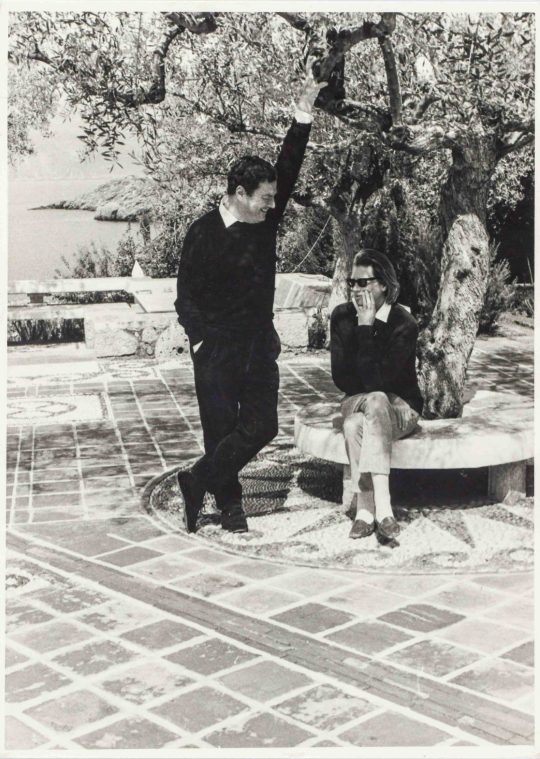
But some of Paddy’s life energy was sucked out of him when Joan died in Kardamyli in June 2003, aged 91. It was related that Joan said to her friend Olivia Stewart, who was visiting: 'I really would like to die but who'd look after Paddy?' Olivia said that she would. A few minutes later, Joan fell, hit her head - and died instantly of a brain haemorrhage. Joan had often quoted Rilke: 'The good marriage is one in which each appoints the other as guardian of his solitude.' Now Paddy Leigh Fermor was all alone.
Leigh Fermor was knighted in 2004, the day of his birthday which he delighted in like a giggling schoolboy. But he missed Joan terribly.
For the last few months of his life Leigh Fermor suffered from a cancerous tumour, and in early June 2011 he underwent a tracheotomy in Greece. As death was close, according to local Greek friends, he expressed a wish to visit England to bid goodbye to his friends, and then return to die in Kardamyli, though it is also stated that he actually wished to die in England and be buried next to his wife, Joan, in Dumbleton, Gloucestershire. He stayed on at Kardamyli until the 9th June 2011, when he left Greece for the last time. He died in England the following day, 10th June 2011, aged 96. It was reported that he had dined in full black tie on the evening of his death. Paddy had style even unto the end.

A Guard of Honour was formed by the Intelligence Corps and a bugler from his former regiment, the Irish Guards, delivered the ‘Last Post’ at Paddy’s funeral. As had been his wish, he was buried beside Joan. On his gravestone in Dumbleton cemetery is an inscription in Greek, a quote from Constantine Cavafy: “In addition, he was that best of all things, Hellenic.”
Although Joan had passed away at the age of ninety-one, after suffering a fall in the Mani. Her body was repatriated to Dumbleton, the place of her birth - ironic that her dream was to be as far as she could possibly go from the rolling humdrum Worcestershire hills. But perhaps she intended to return all along. When Paddy was buried beside her it seemed that the ‘pact of liberty’ that these two lonely souls had forged themselves could be tested in the great elsewhere. Joan was more than his muse (as many of her obituaries were at pains to declare) but his greatest adventure.
To come around full circle from the movie ‘Ill Met By Moonlight’ (1957) that I saw that night in Verbier, my father told me that rather poignantly, General Kreipe, the German commander Leigh Fermor had captured - once an enemy, and later a friend - left behind notes and photographs from across his life. On one of those notes, it was discovered, the following was scribbled from a brief visit to Greece: “Somewhere, amidst all the disarray, was the story of Joan and Paddy, and” it concluded, “…of their lives together.”
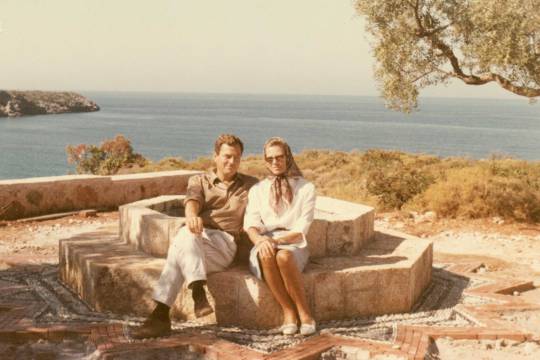
His life with Joan and all that she meant to him was one part of the mosaic of who Paddy Leigh Fermor was. But it’s incomplete.
Paddy didn’t like the idea of a biography, and neither did Joan when she was alive. But friends had persuaded them that unless Paddy appointed someone to write his life, he might find himself the subject of a book whether he liked it or not. In Artemis Cooper they couldn’t have chosen a better writer to chronicle Paddy’s life as a man of action and letters. Cooper, was the daughter of another accomplished diplomat and historian, John Julius Norwich, and grand-daughter of Duff and Diana Cooper. As the wife of the historian Antony Beevor, she became a trusted friend of the Leigh Fermors. Cooper was too good of a historian to let her friendship lead her astray from being a faithful but serious biographer. Knowing this, she was told she could go ahead, but she had to promise not to publish anything until after they were both dead.
Paddy did not like being interviewed, and would keep her questions at bay with a torrent of dazzling conversation. He was the master at deflecting discussions away from himself.
He was also very unwilling to let Cooper see many of his papers, though the refusal always couched in excuses. ‘Oh dear, the Diary…’ It was the only surviving one from his great walk across Europe, and I was aching to read it. ‘Well it’s in constant use, you see, as I plug away at Vol III,’ he would say. Or, ‘My mother’s letters? Ah yes, why not. But it’s too awful, I simply cannot remember where they’ve got to…’ It was quite obvious that he and Joan, while being unfailingly generous, welcoming and hospitable, were determined to reveal as little as possible of their private lives.
While they were more than happy to talk about books, travels, friends, Crete, Greece, the war, anything - they would not tell her any more than they would have told the average journalist. But she persisted and got closer than most. He showed particularly gallantry in not talking about his romantic entanglements. But she soon twigged that anytime he described a woman as ‘an old pal’ it was a sure bet that he had an affair with her.
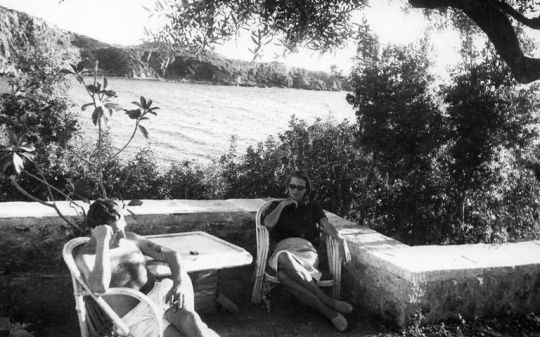
Intriguingly, Paddy liked to claim he was descended from Counts of the Holy Roman Empire, who came to Austria from Sligo. Paddy could recite ‘The Dead at Clomacnoise’ (in translation) and perhaps did so during a handful of flying visits to Ireland in the 1950s and 1960s, partying hard at Luggala House or Lismore Castle, or making friends with Patrick Kavanagh and Sean O’Faolain in Dublin pubs. He once provoked a massive brawl at the Kildare Hunt Ball, and was rescued from a true pounding by Ricki Huston, a beautiful Italian-American dancer, John Huston’s fourth wife and Paddy’s lover not long afterwards.
And yet, a note of caution about Paddy’s Irish roots is sounded by his biographer, Artemis Cooper, who also co-edited ‘The Broken Road’, the final, posthumously published instalment of the trilogy. “I’m not a great believer in his Irish roots,” she said of Leigh Fermor in an interview, “His mother, who was a compulsive fantasist, liked to think that her family was related to the Viscount Taaffes, of Ballymote. Her father was apparently born in County Cork. But she was never what you might call a reliable witness. She was an extraordinary person, though. Imaginative, impulsive, impossible - just the way the Irish are supposed to be, come to think of it. She was also one of those sad women, who grew up at the turn of the last century, who never found an outlet for their talents and energies, nor the right man, come to that. All she had was Paddy, and she didn’t get much of him.”
And I think that’s the point, no one really got much of Paddy Leigh Fermor even as he only gave a crumb of himself to others but still most felt grateful that it was enough to fill one’s belly and still feel overfed by him.
Paddy never tried to get to the bottom of his Irish ancestry, afraid, no doubt, of disturbing the bloom that had grown on history and his past, a recurring trait. “His memory was extraordinary,” Artemis Cooper noted, “but it lay dangerously close to his imagination and it was a very porous border.”
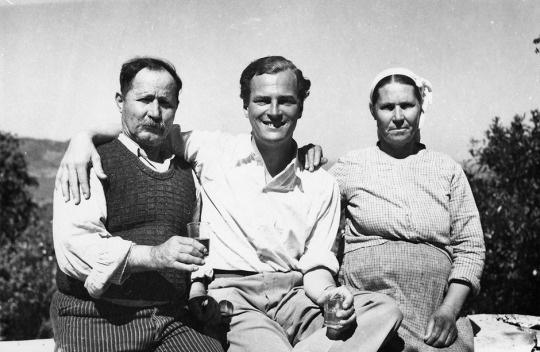
Within the Greek imagination many Greeks saw in Paddy Leigh Fermor as the second coming of Lord Byron. It’s not a bad comparison.
Lord Byron claimed that swimming the Hellespont was his greatest achievement. 174 years or so later, another English writer, Patrick Leigh Fermor - also, like Byron, revered by many Greeks for his part in a war of liberation - repeated the feat. Leigh Fermor, however, was 69 when he did it and continued to do it into his 80s. Byron was a mere 22 years old lad. The Hellespont swim, with its mix of literature, adventure, travel, bravery, eccentricity and romance, is an apt metaphor for Leigh Fermor’s life. Paddy Leigh Fermor was the Byron of his time. Both men had an idealised vision of Greece, were scholars and men of action, could endure harsh conditions, fought for Greek freedom, were recklessly courageous, liked to dress up and displayed a panache that impressed their Greek comrades. Like a good magician it was also a way to misdirect and conceal one’s true self.
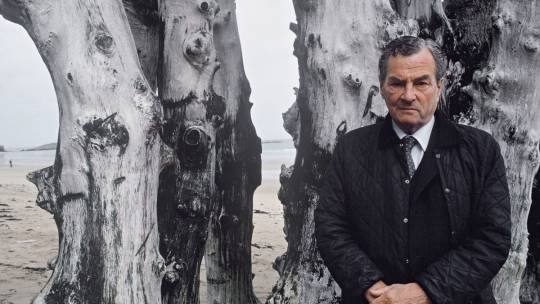
What or who was the true Paddy Leigh Fermor?
Like Byron, Leigh Fermor appeared as a charismatic and assured figure. He was a sightseer, consuming travel, culture, and history for pleasure. He was an aristocrat moving in the social circles of his time. He was a gifted amateur scholar, speculating on literary and historical sources. Leigh Fermor, Byron’s own identity, is subject to textual distortion; it emerges from a piece of occasional prose in his books and is shaped by the claims of correspondence on a peculiarly fluid consciousness.
There is no hard and fast distinction to be drawn here between real and imagined, only a continuity of relative fictions that lie between memory and imagination as his biographer asserted. If there is a will to assert identity here, to disentangle fact and fiction, to give things as they really are and nail down the real Leigh Fermor then it is somewhere between the two. This is where we will find Paddy.
For many his death marked the passing of an extraordinary man: soldier, writer, adventurer, a charmer, a gallant romantic. As a writer he discovered a knack for drawing people out and for stringing history, language, and observation into narrative, and his timing was perfect. Paddy often indulged in florid displays of classical erudition. His learned digressions and serpentine style, his mannered mandarin gestures, even baroque prose, which Lawrence Durrell called truffled and dense with plumage, were influenced by the work of Charles Doughty and T.E. Lawrence. But one can’t compare him. I agree with the acclaimed writer Colin Thurbon who said, “There is, in the end, nobody like him. A famous raconteur and polymath. Generous, life-loving and good-hearted to a fault. Enormously good company, but touched by well-camouflaged insecurities. I would rank him very highly. ‘The finest travel writer of his generation’ is a fair assessment.”
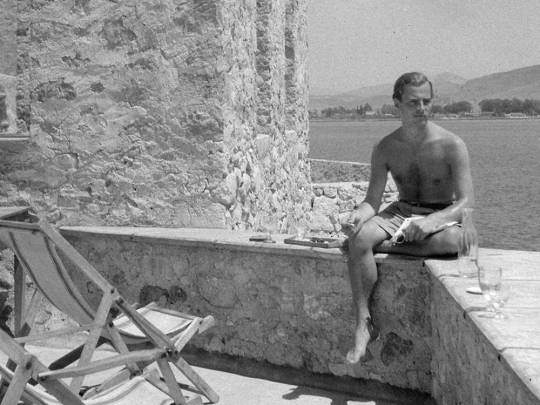
As a child I didn’t really know who Paddy Leigh Fermor was other than this very cheerful and charismatic old man was kind, attentive, and took a boyish delight in everything you were doing. Only later on in adulthood was it clear to that Paddy was not only among the outstanding writers of his time but one of its most remarkable characters, a perfect hybrid of the man of action and the man of letters. Equally comfortable with princes and peasants, in caves or châteaux, he had amassed an enviable rich experience of places and people. “Quite the most enchanting maniac I’ve ever met,” pronounced Lawrence Durrell, and nearly everyone who’d crossed paths with him had, it seemed, come away similarly dazzled.
I am equally dazzled - more smitten in retrospect - for alas they don’t make men like Paddy any more. But every time I dip back into his books I think I discover a little bit more of who Paddy Leigh Fermor was because I find him some where between my memory and my imagination.
#essay#paddy leigh fermor#leigh fermor#joan raynor#joan leigh fermor#greece#crete#second world war#SOE#war#british army#history#general kreipe#stanley moss#literature#author#writer#travel#explorer#wanderlust#travel writing#europe#mani#peloponnese#kardamlyi#lord byron#ill met by moonmight#film#movie#personal
115 notes
·
View notes
Text
SAINT OF THE DAY (December 3)

On December 3, the Roman Catholic Church honors St. Francis Xavier, one of the first Jesuits who went on to evangelize vast portions of Asia.
Francis Xavier was born on 7 April 1506 in the Kingdom of Navarre, a region now divided between Spain and France.
His mother was an esteemed heiress while his father was an adviser to King John III.
While his brothers entered the military, Francis followed an intellectual path to a college in Paris. He studied philosophy and later taught it after earning his masters degree.
In Paris, the young man would discover his destiny with the help of his long-time friend Peter Faber and an older student named Ignatius Loyola — who came to Paris in 1528 to finish a degree and brought together a group of men looking to glorify God with their lives.
At first, personal ambition kept Francis from heeding God's call. Ignatius' humble and austere lifestyle did not appeal to him.
But the older student, who had undergone a dramatic conversion, often posed Christ's question to Francis:
“What will it profit a man to gain the whole world and lose his own soul?”
Gradually, Ignatius convinced the young man to give up his own plans and open his mind to God's will.
In 1534, Francis Xavier, Peter Faber, and four other men joined Ignatius in making a vow of poverty, chastity, and dedication to the spread of the Gospel through personal obedience to the Pope.
Francis became a priest in 1537. Three years later, Pope Paul III confirmed Ignatius and his companions as a religious order — the Jesuits.
During that year, the king of Portugal asked the Pope to send missionaries to his newly-acquired territories in India.
Together with another Jesuit, Simon Rodriguez, Francis first spent time in Portugal caring for the sick and giving instruction in the faith.
On his 35th birthday, he set sail for Goa on India's west coast.
There, however, he found the Portuguese colonists causing disgrace to the Church through their bad behavior.
This situation spurred the Jesuit to action.
He spent his days visiting prisoners and the sick, gathering groups of children together to teach them about God, and preaching to both Portuguese and Indians.
Adopting the lifestyle of the common people, he lived on rice and water in a hut with a dirt floor.
Xavier's missionary efforts among them often succeeded, though he had more difficulty converting the upper classes and encountered opposition from both Hindus and Muslims.
In 1545, he extended his efforts to Malaysia, before moving on to Japan in 1549.
Becoming fluent in Japanese, Francis instructed the first generation of Japanese Catholic converts.
Many said that they were willing to suffer martyrdom rather than renounce the faith brought by the far-flung Jesuit.
St. Francis Xavier became ill and died on 3 December 1552, while seeking a way to enter the closely-guarded kingdom of China.
He was beatified by Paul V on 25 October 1619.
On 12 March 1622, both Francis Xavier and Ignatius Loyola were canonized by Pope Gregory XV.
Pius XI proclaimed him the "Patron of Catholic Missions."
9 notes
·
View notes
Text
William Willis
William Willis was born in 1921 in Waco, Texas. His parents were affluent, college-educated African Americans. His father served first as an educator and then started a construction company. The family moved to Dallas when Willis was two "partly in response to an ultimatum from the Waco Klu Klux Klan" (Zumwalt 1). His father died a few years later and he was raised by his mother. Although he attended segregated schools, his family also traveled widely -- a habit he would keep up throughout his life.

William Willis from his Howard yearbook, via AmPhilSoc (as are all other images in this page)
Willis was a quiet, bookish child and went on to Howard University, where he graduate cum laude in 1942. It was there that he developed an interest in the sociology and history of the Black experience int he United States. Once out of school, he volunteered to join the Coast Guard and spent the war stationed in Boston. Afterwards, he decided to attend graduate school in anthropology at Columbia because he "assumed that this discipline was the vanguard in the attack against racist thought" (Zumwalt 2). He was thus in the same class of students as Eric Wolf, Marvin Harris, Morton Fried, Sydney Mintz, and Robert Murphy. He became interested in the history of Black and Indian relations, as wrote a dissertation based on library research on "colonial conflict and the Cherokee Indians, 1710-1760" and recieved his Ph.D. in 1955.
During his time at Columbia he married his life partner Georgine "Gene" Upshur, who came from a prominent African American family in Philadelphia. Her father was a Republican congressman in Pennsylvania's lower house and also, as it happened, the mortician who buried Bessie Smith, the great blues singer. She earned a BA in sociology and wanted to go on to study social work, but he father agreed to support her studies only if she also went to mortician school so that she would have a steady source of financial support. "People will always need an undertaker" he told her (Zumwalt 5). She was doing her masters in social work when she met Willis.

From 1955 to 1964 Willis tried unsuccessfully to pursue a career in anthropology. He applied to the Ford Foundation for a research grant and was turned down. He applied for teaching positions but was told by Duncan Strong (the department chair at Columbia) that no one would hire a black person. He and his wife lived in New York for nearly a decade and Willis published work while teaching part-time as a lecturer at Columbia and City College. In 1963 Willis's mother died of a heart attack and Willis and Gene decided to move back to Dallas to live in the family home.
Willis's luck turned on his return to Dallas. It was 1964, the high-water mark of the civil rights movement, and Southern Methodist University was looking to integrate its faculty. In 1965 he was hired to a position in anthropology. He was a tremendous success at the new institution, drawing large classes of students and helping to establish an MA and Ph.D. program in the department. He earned tenure and became a full professor. His wife became active in several local organizations -- at last, the Willis's were flourishing.
In the late 1960s, life again became difficult for Willis. His department chair, a racist, began harassing him -- this included actions like changing the locks on the office to his door and not giving him the key. Administrators above him supported his chair's behavior. Radical black politics came to campus, and militant student activists began making increasingly large demands on the administration. Willis -- a quite, reserved man who alway wore a bowtie in public -- found himself deeply sympathetic to the activists and became radicalized himself. As the only black professor on campus, he became a key player negotiating their relationship to the administration. It was in this context that he wrote his piece "Skeletons in the Anthropological Closet". He considered alternate titles for the essay, including "anthropologist as vulture" and "anthropologist as exploiter".

Willis at SMU, via APS
The Willises found it difficult to bear the brunt of the constant harassment they faced at SMU. Their health began to break down. Willis experienced constant pain in his abdomen and was afraid it was cancer -- in fact, it was stress. Gene began fainting in public. Willis decided to take a leave of absence in 1971 to recover. The administration then altered his request to make it a 'terminal leave of absence', making it sound as if he had resigned his position! Willis fought back against this attempt to remove him, but soon realized that if he stayed at SMU he would spend his entire life fighting the administration for his rights. When his leave of absence was over, he resigned from SMU. He had been there less than a decade.
Willis and Gene moved to Philadelphia, Gene's home town. They moved in with her mother and Gene's mortician experience ended up proving valuable, and the family business helped support both her and Willis. One of the upsides of the move was that the American Philosophical Society was based in Philly. Willis began his next and (as it turns out) final project there, combing through the massive archive of the Franz Boas paper. He became a fixture in the reading rooms of the society, well-known to the librarians and archivists who worked there. His initial plan was to write about the sort shrift Boas and his colleagues gave to Black Americans, but the more time he spent reading Boas, the more ambivalent he became. He came to see Boas as both an anti-racist activist and someone who at times seemed to harbor racist views of Black people.
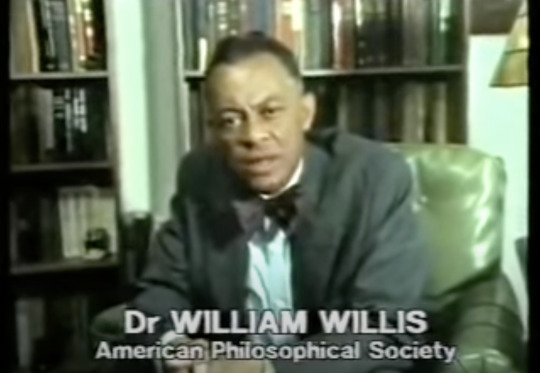
Willis in the PBS Special "Shackles of Tradition" about Franz Boas. The entire documentary is on YouTube
Wilis began writing a book on the history of American anthropology's study of African Americans. Alas, this study was never to be finished. On 8 August 1983 Willis left the reading room, went home, and died of a massive heart attack. He was 62 years old. His papers are now in the APS library and his wife Gene has established a fund to support the study of race (APS Willis feature).
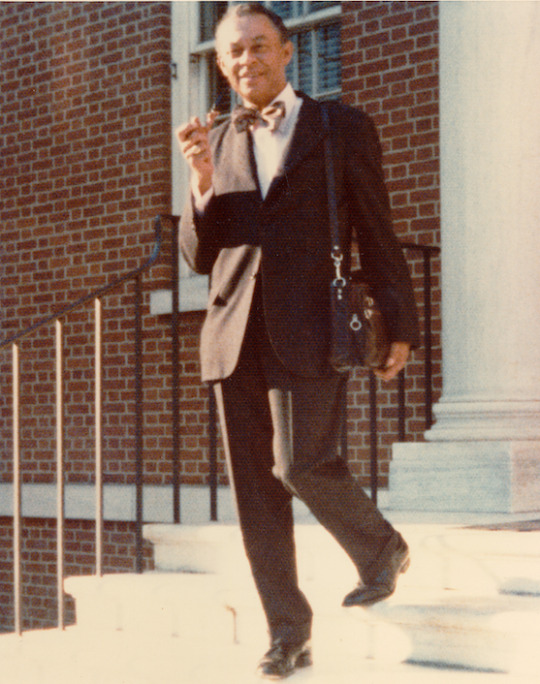
Via APS
Willis had little lasting influence on the discipline of anthropology. Although his "Skeletons" essay is now more widely taught, he did not train graduate students who could keep his memory alive. The first chapter of his book on Boas was published posthumously, but the rest of the work was already created. Today, Willis is remembered as a pioneer of African American anthropology but, to be honest, his biography shows us both the story of a model scholar and the tragedy of race in America.
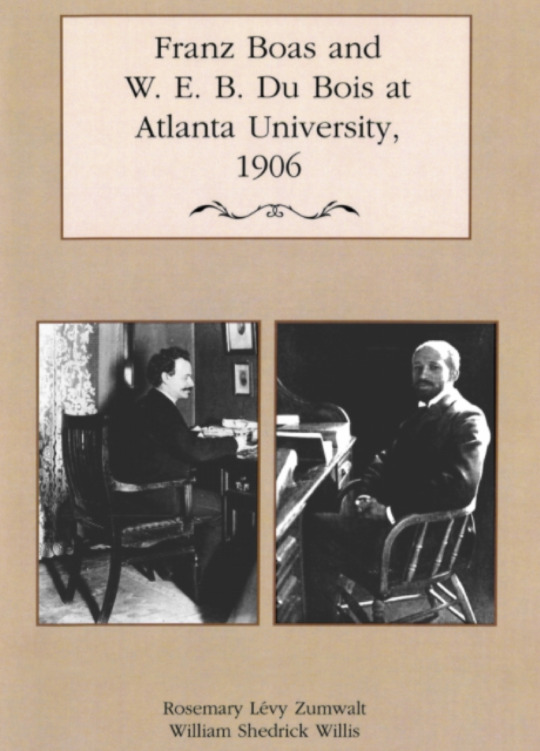
Willis's final volume is available on JSTOR.
52 notes
·
View notes
Note
🔮,🐶,☕
:D
🔮- What's your dream job?
I wish to become a pilot in the military! What branch you ask? That my friend is where I'm confused. My main goal was to become a fighter pilot in the Navy, but alas, that wasn't meant to be as the Indian Navy doesn't allow women to become fighter pilots, but only reconnaissance pilots in the Navy. So I've kept joining the Indian air force as Plan B, but i still have the urge to pursue becoming a pilot in the Navy. Coast guard is Plan C, I guess xD
🐶- Are you a cat or dog person?
Uhh a cat person. I really do love dogs and I have a dog with me! But in my grandmother's house, there's 4 cats! And well, even though only 1 out of all 4 seem to show affection towards me, i just love them. So technically, i just seem to love cats a bit more than dogs.
☕- Coffee or tea?
Coffeeeee! When i tasted tea for the first time, i hated it. I never tasted it again. Maybe i should give it another try. But that's in the future lol.
5 notes
·
View notes
Text

Phantom Plane Crashes
Phantom Plane Crashes are a relatively recent phenomenon, but there have been several cases reported. The scenario usually goes something like this: Witnesses see a plane going down, often in flames. They hear the crash and feel the ground shake as the plane impacts. Sometimes smoke and flames are seen, and witnesses can smell spilled fuel. Upon investigation, however, no sign of a crash is evident.
Not only is no wreckage ever found, but no record of a missing or delayed flight is cataloged. So what are these people experiencing?
Here are several of these mysterious reports from around the country.
People in Westbrook, Connecticut were amazed Wednesday morning, January 15, 1997 when they heard that a single-engine plane dive toward the waters of Long Island Sound… and then vanish. According to the newspaper The Day, “The Coast Guard, state Department of Environmental Protection, two rescue helicopters, fire departments from Westbrook, Old Saybrook, Madison, and Clinton, and some marine patrols and private boats searched 100 square miles after a man reported he had seen a plane dive into the water.
“Daniel Bowes of Meetinghouse Lane was having a cup of coffee at about 7:30 a.m. at West Beach on Salt Island Road when he saw a plane flying low over the water, according to Ralph Buck, a captain of the Westbrook Fire Department. He told authorities it looked as if the plane took a nose dive, though he didn’t see a splash, Buck said.
No airport in the area reported any planes missing, according to state police Lt. Cliff M’Sadoques.”
At 4 p.m., the Coast Guard called off the search. No trace of any aircraft was found.
____________________________________________
Three women in the Ovando, Montana, area, about 50 miles northeast of Missoula, reported seeing an airplane trailing smoke, and falling from it were objects looking like parachutes. A ranchwoman told officers she saw a “board-like object” fall from the plane. Sheriff Ed Barrow and a deputy, despite falling temperatures and four feet of snow, made a ground search, joined by a ski-equipped plane which flew over the designated area, but nothing was found.
Two days later, there was a new hope when a boy living near Ovando reported an explosion he had seen on a hillside near his home. He described it as a “big explosion” with red and yellow flames. The time and general location given by the boy agrees with the stories told by the three women, officers said. Malmstrom AFB officials at Great Falls and Civilian Aeronautics Administration authorities all agreed that no planes, military, commercial, or private were missing.
On Feb. 18, Carl Schirmer, coordinator of the Montana search and rescue team announced, “There is nothing warranting any further search. The Sheriff went up where the disturbance was reported to be seen and could not find a thing.”
____________________________________________
“Butler County, Ohio, deputies discontinued a search yesterday afternoon for a plane, which reportedly had crashed in Reily Township near Imhoff and Indian Creek Roads late Wednesday night,” said this newspaper report. “Deputies said an amateur radio operator heard what he thought was a distress call from a plane believed to be flying from Oxford to Cincinnati about 11 p.m.
“About 1:45 a.m. yesterday, George Mosley, 1203 Azel Avenue, Hamilton, his son and two other boys became separated in the same area while coon hunting. During the separation the boys said they saw a white flash in the sky at treetop level, then heard screaming and a crash. Airports in Hamilton and Butler County had no record of any small craft filing a flight plan during those hours. Deputies used a plane and walked the area in search of a downed plane Wednesday night until fog set in on the Reily area. The search was continued yesterday morning and discontinued after nothing was found.”
____________________________________________
Nov. 18, 1955. The first reports told of extensive search parties combing the mountainous region of Dark Hollow, Pennsylvania, looking for a plane believed crashed. The search began after Dale Murphy, civil defense coordinator of Cumberland County, said he received reports from ten GOC members of either hearing or seeing a plane, “probably in trouble,” flying about 1,000 feet.
One spotter said she saw it go out of sight behind a hill, then heard something like an explosion. However, checks with various air control agencies failed to turn up any reports of either a plane missing or in trouble.
Air-sea rescue planes were dispatched by Westover Air Force Base in Massachusetts to aid ground crews in the search. The planes were requested after two flares were reported over a deep ravine in Dark Hollow. But the aerial search by the Air Force and the Civil Air Patrol along with nearly 300 firemen, police, civil defense workers, and volunteers found no trace of a crashed plane. But the persistence of flares renewed the searchers efforts.
On the 20th, yellow flares were reported at 1:30 a.m. and 6 p.m. At 9:30 that night Murphy ordered sirens blown on all fire equipment in the region. Fifteen minutes later, another flare arched into the sky. Finally, on the 22nd Nov., the search was halted, and the “ghost plane” became a legend.
____________________________________________
On November 29, 1996, the day after Thanksgiving, a Miami Township, Ohio, resident was unloading groceries from his car. As he walked into his house, something disruptive happened. “The ground shook, and my house vibrated,” commented the gentleman during an interview from his living room three weeks afterward. “It sounded like two concrete slabs crashing together. I could feel the shock of it. My windows and shades even rattled for about thirty seconds. I’d say that the sound shook the house between seven-thirty and eight,” the witness added. “About a half-hour or so later, the Franklin Police Department showed up checking around for an airplane crash.”
Later that same night, a visit to the Franklin Police Department to inquire about the Franklin search with Lieutenant Massey revealed some conflicting information. “I believe your witness is mistaken,” Massey said. “Our search and rescue operation didn’t begin until 9:07 p.m., which was in response to the county-wide advisement of a possible plane down in the area.”
The search and rescue mission was enormous, and was conducted by several police agencies from the Warren and Montgomery County areas. The search began at 8:49 p.m. when the Miami Township police headquarters received a telephone call from the FAA Flight Service Station located at the Dayton International Airport. Apparently, Rescue Coordination Services advised the Miami Township department of the detection of an ELT beacon (Emergency Locator Transmission), which had originated from an area two miles west of Dayton General Airport. Strangely, the ELT signal was not received locally, as would be expected, but rather was detected by orbiting satellite.
Once the rescue operation was enacted, the search crews raced into an area west — and then later south — of the Wright Brothers/South Dayton General Airport. The reasoning behind the initial change in the search locations is that the ELT signal was evidently changing position, appearing first approximately 15 miles to the northwest of the Wright-Brothers Airport, and then was strangely tracked to a distance of over two miles west of the airport.
At 9:17 p.m., Springboro and Miamisburg units on foot began to detect the profuse smell of hot burning rubber. Strangely, a third location on State Route 741 is also where a second area resident complained of an explosive sound heard, also between 7:30 p.m. and 8:00 p.m. No physical evidence is known to have been recovered that would indicate there was an aircraft emergency resulting in a crash, as no known debris has been found.
The entire state of affairs regarding the mystery ELT signal, loud booming and crashing sounds heard by independent witnesses from two locations, the visual observation of an object with one red light, the uncertain chain of events at Post 83, the radar track announced to the police agencies by the Dayton International Airport, the smell of burning rubber, the subsequent denial of certain reporting procedures by the DIA which were later found to have occurred, the lack of log entries maintained by DIA operators, the subsequent inquiries as to how the calls were handled by C.A.P., and the involvement of Langley in announcing this to Flight Services are various issues that remain unresolved in this tangled, complicated drama.
#Phantom Plane Crashes#ghost and hauntings#paranormal#ghost and spirits#haunted locations#haunted salem#myhauntedsalem#unsolved mystery
16 notes
·
View notes
Text
Indian Cost Guard Recruitment 2024 Notification Out for 320 Posts, Apply Online
Indian Cost Guard Recruitment 2024: Join Indian Coast Guard has released the Official Notification for Indian Coast Guard Recruitment 2024. If any candidate who wants to apply for Indian Coast Guard posts and read this article to know about eligibility, age limit, selection process, salary, online date, etc. Before applying online must read eligibility criteria and then fill application form…

View On WordPress
0 notes
Text
Join Indian Coast Guard ICG has released the advertisement of Yantrik and Navik General Duty GD CGEPT 01/2025 Batch Recruitment 2024. All the candidates who want to apply in this Recruitment can apply online. See advertisement for other recruitment related information like syllabus, qualification, age limit, selection procedure.
Application Begin : 03/06/2024
Last Date for Registration : 03/07/2024
https://www.jobkey.in/Coast-Guard-Navik-Yantrik-CGEPT-01-2025-Online-Form-2024.php

0 notes
Text
On the occasion of Indian Coast Guard Day, AIM4 NEET MEDICAL Institute salutes the valor and dedication of the guardians of our seas. 🇮🇳 Embracing the spirit of maritime security, AIM4 instills similar principles in aspiring medical professionals. Our institute upholds the values of discipline, commitment, and service to society. Join AIM4 in honoring the Indian Coast Guard, embodying their resilience and selflessness in your journey towards medical excellence. Just as they safeguard our shores, AIM4 stands as a beacon guiding you through the waves of medical education. Celebrate Indian Coast Guard Day with AIM4 – where commitment meets success.

#jaipur neet coaching#top neet coaching in jaipur#best neet coaching in jaipur#best neet coaching center in jaipur#top insititue for neet
1 note
·
View note
Text

Introduction
Embarking on a career in the Indian Navy after graduation is a commendable choice, and the right training can make all the difference. Manasa Defence Academy stands out as a beacon of excellence, providing top-notch coaching for NDA, Navy, Army, Airforce, SSC, Coast Guard, and various central government jobs. Let's explore the unparalleled offerings of this academy, nestled in the heart of Visakhapatnam, Andhra Pradesh.
Courses Offered by Manasa Defence Academy
NDA Training
Manasa Defence Academy specializes in National Defence Academy (NDA) training, laying a strong foundation for aspirants aiming to join the armed forces.
Comprehensive Military Training
Beyond NDA, the academy excels in providing coaching for the Navy, Army, Airforce, SSC, Coast Guard, and other central government job exams.
Top-Quality Facilities
Physical Fitness Training by Retired Army Officer
The academy ensures the physical fitness of its cadets through training led by a retired Army officer, fostering discipline and resilience.
State-of-the-Art Facilities
From a well-equipped gym to yoga and swimming facilities, the academy offers a holistic approach to physical well-being.
Written Exam Preparation
Cadets receive comprehensive guidance for written exams, ensuring they are well-prepared for the challenges ahead.
SSB Interviews and Personality Development
Cracking the SSB Code
Understanding the importance of SSB interviews, Manasa Defence Academy provides specialized training to enhance candidates' personality and communication skills.
Language Skills
The academy focuses on developing English and Hindi speaking skills, a crucial aspect for success in defense-related interviews and examinations.
Group Discussions and Stage Speech Training
Cadets are groomed in the art of group discussions and stage speeches, instilling confidence and eloquence.
Fee Structure and Accessibility
Affordable Fee Structure
Manasa Defence Academy believes in making quality training accessible, offering an affordable fee structure for students from diverse backgrounds.
Continuing Higher Studies
The academy recognizes the importance of education and allows cadets to continue their higher studies after 10th, providing a seamless academic journey.
Location
Visakhapatnam: The Ideal Setting
Situated in Visakhapatnam, Andhra Pradesh, the academy benefits from a strategic location, providing an ideal environment for focused training.
Advantages of the Location
Proximity to defense establishments and a conducive atmosphere for learning make Visakhapatnam an optimal location for Manasa Defence Academy.
Success Stories
Real-Life Achievements
The academy boasts numerous success stories of alumni who have excelled in various defense and government job roles.
Achievements in Defense and Government Jobs
Graduates of Manasa Defence Academy have made their mark, contributing to the nation's defense and securing coveted government positions.
Why Choose Manasa Defence Academy?
Testimonials Speak Louder
Current and former cadets vouch for the academy's effectiveness, citing personalized attention and a supportive learning environment.
Unique Selling Points
Manasa Defence Academy stands out with its dedicated faculty, practical training modules, and a commitment to producing successful candidates.
Commitment to Excellence
The academy is dedicated to excellence, continuously adapting its training methodologies to align with evolving examination patterns.
Conclusion
In the pursuit of a career in the Indian Navy or other defense sectors, choosing the right training institute is pivotal. Manasa Defence Academy not only imparts knowledge but also molds individuals into confident and disciplined professionals. As you embark on this journey, remember that the right training can transform aspirations into reality.
FAQs
How long is the training at Manasa Defence Academy?
Manasa Defence Academy offers varying course durations. The length depends on the specific program, ranging from a few months to a year.
Can I apply if I'm still in college?
Yes, the academy accepts applications from individuals currently pursuing their graduation. The training schedule is designed to accommodate students' academic commitments.
What sets Manasa Defence Academy apart from others?
The academy's commitment to personalized attention, experienced faculty, and a holistic approach to training distinguishes it from others.
How can I enroll in the academy?
To enroll in Manasa Defence Academy, visit their official website or contact the admissions office for detailed information on the application process.
2 notes
·
View notes
Text
Coast Guard Assistant Commandant Recruitment 2024 (2025 Batch) Apply Online https://www.sarkarijobsinfo.in/coast-guard-assistant-commandant-recruitment-2024/
0 notes
Text
Goa Shipyard Limited seeks Chief General Manager (Commercial) and General Manager (Technical); apply by January 12, 2024.
New Post has been published on https://www.jobsarkari.in/goa-shipyard-limited-seeks-chief-general-manager-commercial-and-general-manager-technical-apply-by-january-12-2024/
Goa Shipyard Limited seeks Chief General Manager (Commercial) and General Manager (Technical); apply by January 12, 2024.
Goa Shipyard Limited (GSL) is a government undertaking under the Ministry of Defence, engaged in designing and building ships for the Indian Navy and Indian Coast Guard. GSL is inviting online applications from qualified Indian nationals for various posts under different disciplines. The available positions include Chief General Manager (Commercial) and General Manager (Technical). The upper age limit for these posts is 54 and 52 years respectively. Interested candidates can apply online through the website www.goashipyard.in. The online application submission period is from December 13, 2023, to January 12, 2024. After submitting the online application, candidates need to send hard copies of relevant documents to Goa Shipyard Limited by January 22, 2024. For more details and guidelines on applying, applicants can visit the website or contact [email protected].
Goa Shipyard Limited is a shipbuilding and ship repair company under the Ministry of Defence, Government of India.
The company is certified under ISO 9001:2015, 14001:2015, and 45001:2018.
Goa Shipyard Limited is inviting online applications for various posts under different disciplines.
The available positions include Chief General Manager (Commercial) and General Manager (Technical).
Interested candidates can apply online through the company’s website.
The last date to apply online is January 12, 2024, and the hard copy of the application must be submitted by January 22, 2024.
Detailed information about the qualifications, experience, and application process can be found on the company’s website.
Introduction
Goa Shipyard Limited (GSL) is a shipbuilding and ship repair company under the Ministry of Defence, Government of India.
GSL is certified under ISO 9001:2015, 14001:2015, and 45001:2018.
GSL invites online applications for various posts under different disciplines.
Chief General Manager (Commercial)
Position: Chief General Manager (Commercial)
Number of vacancies: 01
Upper age limit: 54 years
Scale of Pay (IDA – Revised 2017) & Grade: Rs.120000-3%-280000(E-8)
General Manager (Technical)
Position: General Manager (Technical)
Number of vacancies: 01
Upper age limit: 52 years
Scale of Pay (IDA – Revised 2017) & Grade: Rs. 100000-3%-260000(E-7)
Application Process
Eligible candidates can apply online through the company’s website.
Online application period: From 00.00 hrs on 13.12.2023 till 17.00 hrs on 12.01.2024.
Hard copy submission deadline: January 22, 2024.
Detailed information about qualifications, experience, and application process available on the website.
Unmatchable Track Record
GSL has an unmatched track record of execution and delivery.
The company has successfully designed and built ships for the Indian Navy and Indian Coast Guard.
GSL’s expertise and experience make it a reliable choice for shipbuilding projects.
Join a Prestigious Organization
By joining Goa Shipyard Limited, you become part of a prestigious organization under the Ministry of Defence.
GSL offers a challenging and rewarding work environment.
You will have the opportunity to work with talented professionals in the shipbuilding industry.
Deadline Reminder
Last date to apply online: January 12, 2024.
Hard copy submission deadline: January 22, 2024.
Don’t miss the chance to be a part of GSL’s exceptional team.
Embrace the Future with Goa Shipyard Limited
Goa Shipyard Limited offers unparalleled opportunities in shipbuilding and ship repair.
Join us to unleash excellence and contribute to India’s maritime strength.
Apply now and be a part of GSL’s unmatchable track record of execution and delivery.
You see the following because WP_DEBUG and WP_DEBUG_DISPLAY are enabled on this site. Please disabled these to prevent the display of these developers' debug messages.
The `the_content` filter applied.
The `the_content` filter applied.
The `the_content` filter applied.
true
Not an instance if `WP_Post`.
Not an instance if `WP_Post`.
Not an instance if `WP_Post`.
NULL
Post eligible.
Post eligible.
Post eligible.
false
0 notes
Text

-------o0o--------


She was demure and elegant in a flowing gown – he looked dapper and debonair in a tailored navy suit.
So pity the poor bride and groom whose lavish Caribbean nuptials were overshadowed by such glamorous guests.
Then again, if you will invite Prince Harry and his actress girlfriend Meghan Markle to your wedding, what do you expect?
All eyes were on the young lovers as the prince attended the wedding of friend Tom ‘Skippy’ Inskip at the weekend in Montego Bay, Jamaica.
Not having seen each other for a fortnight, Harry, 32, and 35-year-old Meghan used the trip as an excuse for a romantic reunion – and their affectionate behaviour set tongues wagging that it might not be long before they, too, are walking up the aisle.
For Meghan, the surroundings are not entirely unfamiliar.
In 2011, she married her first husband – film producer Trevor Engleson – at a resort just 60 miles along the coast. So, is she feeling the love second time around?
We reveal exactly what the young couple got up to on their romantic West Indian weekend...
He flies in economy, while she takes a private jet
Harry arrived in Jamaica on Wednesday to join the groom’s party ahead of the big day – he was one of 14 ushers.
The royals don’t use private planes for personal engagements, so he took a Virgin Atlantic flight from Gatwick to Sangster International Airport in Montego Bay.
The prince did splash out on a premium economy seat, costing upwards of £2,000 return.
Meghan flew in the following day from Toronto, where she’s filming US legal drama Suits, in a private jet that belongs to a friend.
Ever the gentleman, Harry picked her up from the airport, greeting her with a kiss before they drove back to the hotel together.
The luxury resort where JFK stayed
With 110 acres of lush tropical gardens, suites designed by Ralph Lauren and its own private bay, the wedding reception venue is the perfect backdrop for royal romance.
The Round Hill Resort was built in the 1950s as a series of luxurious cottages for rich and famous visitors. Guests have included JFK and Jackie Kennedy, who spent their honeymoon here.
Grace Kelly, Fred Astaire, Clark Gable, Sir Paul McCartney, and Emma Watson have also stayed.
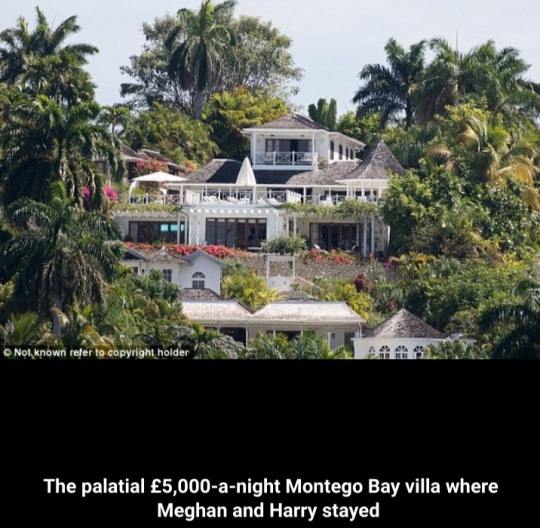
A hotel worker revealed that Meghan and Harry stayed in a £5,000-a-night premium luxury villa, the resort’s most exclusive accommodation away from prying eyes, which comes with its own housekeeper, two pools and a games room with a bar and pool table.
Ever watchful of their safety, security guards were stationed in rooms nearby.
Guests have breakfast served on their balcony, and options include Jamaican delicacies such as ackee (a fruit like a lychee), saltfish with fried dumplings and callaloo (a leafy green vegetable).
It’s quite a change from Meghan’s first trip to the island during her low-key wedding in 2011.
She and her husband-to-be stayed at the four-star Jamaica Inn in Ocho Rios, where they indulged in drinking games and wheelbarrow races before saying their vows.

The (other) very happy couple
It takes a brave bride to invite glamorous, leggy Meghan to your wedding. But flame-haired Lara Hughes-Young didn’t seem bothered about being outshone.
Lara, 30, a software developer at global technology company ThoughtWorks, knows Harry through her new husband ‘Skippy’, who went to Eton with the prince.
She’s the granddaughter of late Conservative MP Michael Hughes-Young.
Her father holds the title Lord St Helens – making her official title the Honourable Lara Inskip.
She is said to have been ‘singing Meghan’s praises’ since meeting her last year.
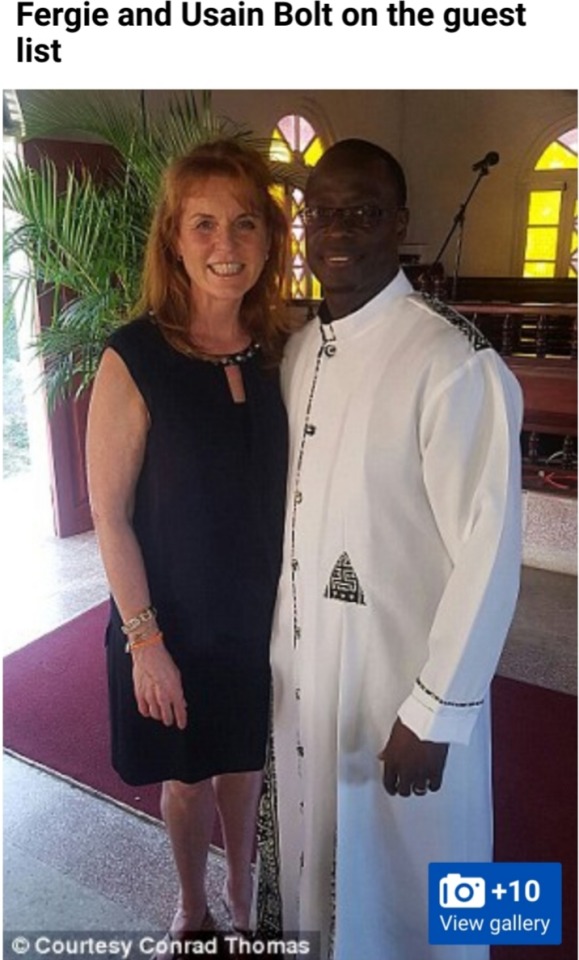
They may have been the focus of attention on the day, but Megan and Harry were far from the only notable guests at the wedding.
Harry’s aunt Sarah Ferguson, the Duchess of York, was on the list, accompanied, insiders say, by her daughter Eugenie.
After the ceremony, a smiling Fergie, wearing a black minidress with a jewelled neck, was seen posing for photographs with Pastor Conrad Thomas, who officiated the ceremony.
Archie Soames, one of the ushers, is the great-grandson of Winston Churchill. Maid of honour Alice St Clair Erskine is an actress who portrayed the Duchess of Cambridge in the 2011 American TV show William and Catherine: A Royal Romance.
Olympic sprinter Usain Bolt is rumoured to have popped in for the party.
Trying not to upstage the bride
For the ceremony, Meghan chose a £1,200 floral print maxi dress by Canadian designer Erdem.
Harry opted for a bespoke navy suit, believed to be from his favourite Savile Row tailor Gieves & Hawkes, and teamed with a yellow rose.
Meghan accessorised her elegant attire with a nude clutch bag and a pair of £249 gold-rimmed sunglasses by Dior to shield her eyes from the hot Jamaican sun.
The bride did her best to stay in the spotlight in a breathtakingly simple white satin gown with a plunging neckline and full, flowing skirt – a direct contrast to Meghan’s high-necked style.

Meghan's tender touch for her prince
Meghan placed a protective arm on Harry’s back as she steered him out of the church and guests say the pair were very tactile throughout the reception as she was introduced to his old friends.
At one point they were seen deep in conversation, as a jacketless Harry drank a beer and Meghan an Aperol spritz cocktail as she continued to rub his back.
Minutes later, she moved even closer, gazing into his eyes and putting her arms around his neck.
‘They are both head over heels and don’t care who sees it,’ said an onlooker.


xxx

30 notes
·
View notes
Text
Current Opportunities: Ministry of Culture Recruitment
The Ministry of Culture in India is tasked with the important responsibility of preserving and promoting the country's rich cultural heritage and diversity. This ministry plays a crucial role in safeguarding the art, history, traditions, and various cultural forms that are an integral part of India's identity. To fulfill its mission, the Ministry of Culture Recruitment often conducts recruitment drives to bring in skilled and passionate individuals who can contribute to this vital cause. In this article, we will explore the current opportunities for recruitment within the Ministry of Culture, highlighting the various positions and the application process.

Why the Ministry of Culture?
Working in the Ministry of Culture is not just a job; it's an opportunity to be a guardian of India's cultural heritage. The ministry oversees museums, art galleries, cultural institutions, and a multitude of programs and initiatives that promote and preserve Indian culture. By joining the Ministry of Culture, you become an integral part of these efforts.
Positions Available:
The Ministry of Culture offers a range of positions to cater to different skill sets and qualifications. These positions can include:
Curators: Curators are responsible for managing and preserving cultural artifacts, artworks, and collections in museums and art galleries. They may also be involved in organizing exhibitions and educational programs.
Research Scholars: The ministry often seeks researchers and scholars with expertise in various aspects of Indian culture, history, and art. They may conduct research, publish papers, and contribute to the ministry's knowledge base.
Cultural Promotion Officers: These officers work on promoting Indian culture both domestically and internationally. They may organize cultural events, festivals, and exhibitions to showcase India's diverse cultural heritage.
Administrative Staff: Administrative roles in the ministry include positions such as human resources, finance, and general administration. These roles are essential for the smooth functioning of the organization.
Conservationists: Conservationists are responsible for preserving and restoring cultural artifacts, artworks, and historical sites. They use specialized techniques and knowledge to ensure the longevity of these cultural treasures.
Eligibility Criteria:
The eligibility criteria for each position may vary, but they typically include educational qualifications, relevant experience, and age limits. It's important to carefully review the specific requirements for the position you are interested in.
Application Process:
To apply for positions within the Ministry of Culture, you'll need to keep an eye on their official website and notifications in leading newspapers and employment portals. When a position is advertised, the ministry typically provides detailed instructions on how to apply, including the submission of application forms, required documents, and any relevant fees. It's essential to follow these instructions meticulously to ensure your application is considered.
Competitive Selection:
The Ministry of Culture employs a competitive selection process to ensure that the most qualified and dedicated individuals are chosen for each position. This often involves written examinations, interviews, and, in some cases, group discussions or skill tests.
Embrace a Fulfilling Career:
A career in the Ministry of Culture Recruitment 2023 offers not only job security and financial stability but also the satisfaction of contributing to the preservation and promotion of India's cultural heritage. It's an opportunity to be a part of a rich legacy and to make a meaningful impact on the nation's cultural identity.
Check now:-
Central Medical Services Society
Coast Guard Recruitment
NIN Recruitment 2023 Notification
In conclusion, if you have a passion for India's culture, history, and art, and you want to be part of an organization dedicated to safeguarding these treasures, consider exploring the current opportunities for recruitment within the Ministry of Culture. Your skills and dedication can play a vital role in preserving and promoting India's rich cultural heritage for future generations.
Ministry of Culture Recruitment
0 notes